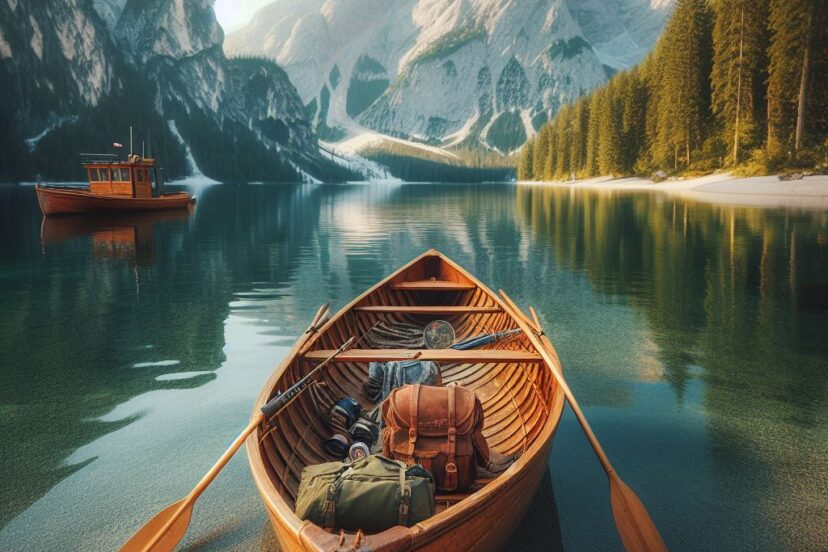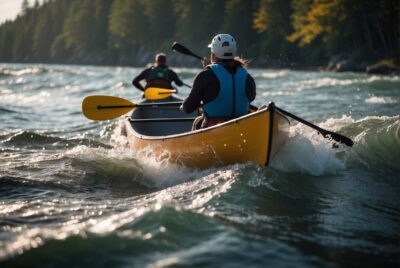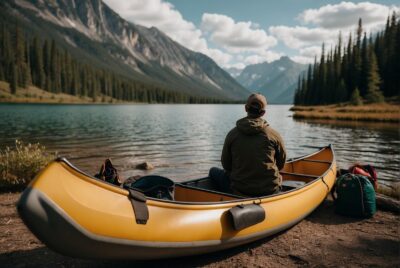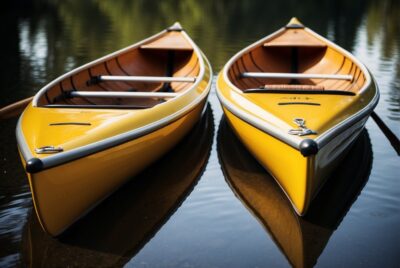Cedar Strip Canoe: The Joy and Craftsmanship
*We may earn a commission for purchases made using our links. Please see our disclosure to learn more.
Cedar Strip Canoe: The Joy and Craftsmanship
Introduction
Embarking on a journey with a cedar strip canoe is like stepping into a world where tradition meets serenity. These canoes, renowned for their elegant craftsmanship and smooth paddling experience, offer a unique blend of history, art, and adventure. In this article, we’ll explore the allure of the cedar strip canoe, from its rich heritage to modern-day innovations, and share insights for enthusiasts and newcomers alike. Whether you’re a seasoned paddler or just starting out, the world of cedar strip canoeing promises a captivating and rewarding experience on the water.
The Allure of a Cedar Strip Canoe
The beauty of a cedar strip canoe is undeniable. Each strip of wood, aligned and varnished, showcases nature’s artistry. But their appeal goes beyond aesthetics. These canoes are known for their durability, able to withstand years of use while maintaining their integrity. When it comes to performance, they offer an incredibly smooth ride. The way they glide through water, with minimal effort, makes them a preferred choice for both novice and experienced paddlers.
History and Evolution
The story of cedar strip canoes is a tapestry woven from history, culture, and innovation. Tracing their origins back to Native American and First Nations peoples, these canoes hold a special place in the history of North American watercraft.
Indigenous Roots and Early Beginnings
The inception of the cedar strip canoe can be traced back to the indigenous peoples of North America. They crafted canoes using what nature provided – primarily birch bark and cedar wood. These early canoes were marvels of engineering, designed to be light yet resilient, capable of navigating the diverse waterways of the continent, from tranquil lakes to rushing rivers. The construction of these canoes was not just about utility; it was a sacred art, deeply intertwined with the cultural and spiritual lives of the builders.
European Influence and Adaptation of a Cedar Strip Canoe
The arrival of European settlers brought new materials and techniques, which led to the evolution of canoe design. The birch bark canoe, while effective, was limited in size and durability. The introduction of cedar strips, fastened together with brass tacks and sealed with pitch or resin, marked a significant advancement. This new method allowed for larger, more durable canoes, capable of carrying heavier loads and withstanding rougher waters.
Golden Age of Canoeing
The late 19th and early 20th centuries saw a boom in recreational canoeing, often referred to as the “Golden Age of Canoeing.” During this time, the cedar strip canoe became a symbol of leisure and exploration. People were drawn to the natural beauty and tranquility of waterways, and the cedar strip canoe was their vessel of choice. Manufacturers began to produce these canoes on a larger scale, introducing various designs and sizes to cater to the growing market of recreational paddlers.
Modern Advancements and Techniques
In the modern era, cedar strip canoes have benefited from technological advancements without losing the essence of their traditional design. The use of fiberglass and epoxy, for instance, has made the canoes more durable and less prone to damage. Modern tools and precise measurements have streamlined the building process, making it more accessible to DIY enthusiasts. Despite these advancements, the core principles of cedar strip canoe construction – precision, patience, and a deep respect for the material – remain unchanged.
Preserving Tradition and Embracing the Future
Today, cedar strip canoes are celebrated not only for their practicality but also for their craftsmanship. They represent a bridge between past and present, a vessel that carries the legacy of traditional canoe building while embracing modern enhancements. This duality ensures that the cedar strip canoe remains relevant and cherished in the world of paddling.
Cedar Strip Canoe in Contemporary Culture
In contemporary culture, these canoes are more than just recreational vessels; they are a testament to a rich heritage and a form of moving art. Enthusiasts and craftsmen continue to build and maintain cedar strip canoes, not only for the joy of paddling but also for the satisfaction of preserving a piece of history. Museums and cultural centers often feature cedar strip canoes, highlighting their historical significance and the skilled artistry that goes into their creation.
Choosing the Right Cedar Strip Canoe
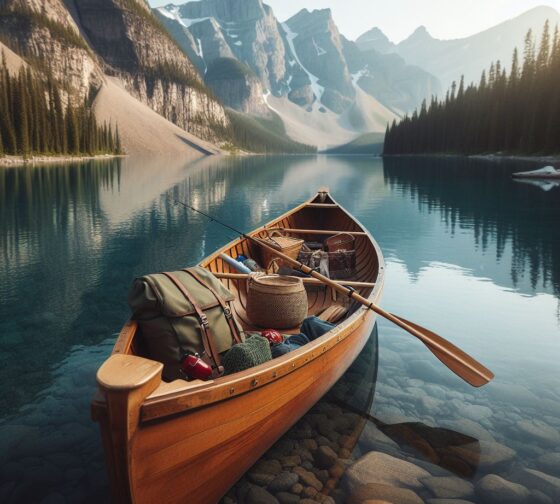
When it comes to selecting a cedar strip canoe, several factors come into play. Size and weight determine maneuverability and capacity. The design can vary from wide, stable models ideal for families, to sleek, fast designs for solo expeditions. Personal preferences, like the type of waterways you’ll navigate and your paddling style, play a crucial role in your choice.
Building Your Own Cedar Strip Canoe
Building a cedar strip canoe is a journey in itself. The process involves selecting high-quality cedar, cutting the strips to precise measurements, and carefully assembling them. The result is a personal masterpiece, a canoe that’s not just a vessel, but a story of patience, skill, and dedication.
Maintenance and Care
Cedar strip canoes require regular maintenance to preserve their beauty and functionality. This includes proper storage away from direct sunlight and moisture, regular varnishing to protect the wood, and inspections for any signs of wear or damage. With proper care, these canoes can last for generations.
Paddling Techniques on a Cedar Strip Canoe
Understanding various paddling techniques is essential for an enjoyable canoeing experience. Beginners should master the forward and reverse strokes for basic navigation. As one progresses, learning advanced maneuvers like the J-stroke or draw stroke can greatly enhance control and efficiency.
Safety Considerations
Safety is paramount in any water activity. Essential gear includes life jackets, a whistle, and a waterproof bag for essentials. Understanding the weather and water conditions is crucial, as is knowing your skill level and limitations. Always plan your route and ensure someone knows your itinerary.
Exploring Waterways
One of the joys of cedar strip canoeing is the ability to explore diverse waterways. These canoes are versatile, suited for calm lakes and gentle rivers. Each trip offers a unique experience, whether it’s a peaceful paddle on a quiet morning or an adventurous journey through winding rivers.
Resources and Recommendations for a Cedar Strip Canoe
For enthusiasts and aspiring canoeists, the world of cedar strip canoeing offers a wealth of resources and recommendations to deepen your knowledge and enhance your experience.
Books and Literature
- “Building a Strip Canoe” by Gil Gilpatrick – This book is a must-have for anyone interested in building their own canoe. It provides detailed instructions, full-size plans, and tips for beginners and experienced builders alike.
- “Canoecraft: An Illustrated Guide to Fine Woodstrip Construction” by Ted Moores – A comprehensive guide that covers everything from selecting materials to the final touches of canoe building. It’s renowned for its thorough explanations and practical advice.
- “The Canoe: A Living Tradition” by John Jennings – This book explores the historical and cultural significance of canoes. It’s a great read for those who appreciate the heritage and artistry behind cedar strip canoes.
- “The Wood and Canvas Canoe: A Complete Guide to Its History, Construction, Restoration and Maintenance” by Jerry Stelmok and Rollin Thurlow – Though focused on wood and canvas canoes, this book offers valuable insights into traditional canoe restoration and maintenance techniques that can be applied to cedar strip canoes.
Online Resources and Forums
- Wooden Canoe Heritage Association (WCHA) – An organization dedicated to preserving the history of wooden canoes. Their website and forums are treasure troves of information, including restoration tips, building techniques, and historical data.
- YouTube Channels – Channels like “Nick Schade – Guillemot Kayaks” offer video tutorials on canoe building and maintenance, providing visual guides that are extremely helpful for DIY builders.
Communities and Groups
- Local Canoeing Clubs – Joining a local canoeing club can offer hands-on experience and the opportunity to learn from seasoned paddlers. These clubs often organize trips, workshops, and social events.
- Social Media Groups – Platforms like Facebook have groups where canoe enthusiasts share their experiences, ask questions, and organize meetups. Look for groups specific to cedar strip canoeing or general canoeing interests.
Workshops and Courses
- Canoe Building Workshops – Various organizations and individual craftsmen offer workshops on building cedar strip canoes. These workshops provide hands-on experience and guidance through the entire process of building a canoe from scratch.
- Paddling Schools and Courses – For those looking to improve their paddling skills, many outdoor centers and canoeing schools offer courses ranging from beginner to advanced levels.
Equipment and Gear Recommendations
- Paddles – Investing in a good quality paddle that suits your style and canoe type is crucial. Brands like Bending Branches and Grey Owl offer excellent options.
- Safety Gear – Essential safety gear includes life jackets (PFDs), helmets for rough water, and waterproof bags for your belongings. Brands like NRS and Stohlquist provide reliable safety equipment.
- Maintenance Supplies – Quality varnishes and wood care products are key to maintaining your cedar strip canoe. Look for marine-grade varnishes and consider environmentally friendly options.
Conclusion
Cedar strip canoeing is more than a pastime; it’s a way of connecting with nature, a craft that combines artistry and skill, and a community of like-minded individuals. Whether you’re gliding across a serene lake or building your own cedar strip canoe, the experience is rewarding and fulfilling. I encourage anyone with a love for the outdoors to embark on this incredible journey.
FAQs
- What makes cedar strip canoes different from other types of canoes? Cedar strip canoes stand out for their beauty, durability, and smooth handling in the water.
- Is building a cedar strip canoe difficult for beginners? It’s a challenging but rewarding project that requires patience and attention to detail.
- How often should a cedar strip canoe be maintained? Regular maintenance, including varnishing and inspections, is recommended at least once a year.
- Can cedar strip canoes be used in rough waters? While they are versatile, it’s important to understand their limits and your skill level for safety.
- Are there any eco-friendly practices for canoeing? Practicing Leave No Trace principles and minimizing impact on waterways are key for sustainable canoeing.

